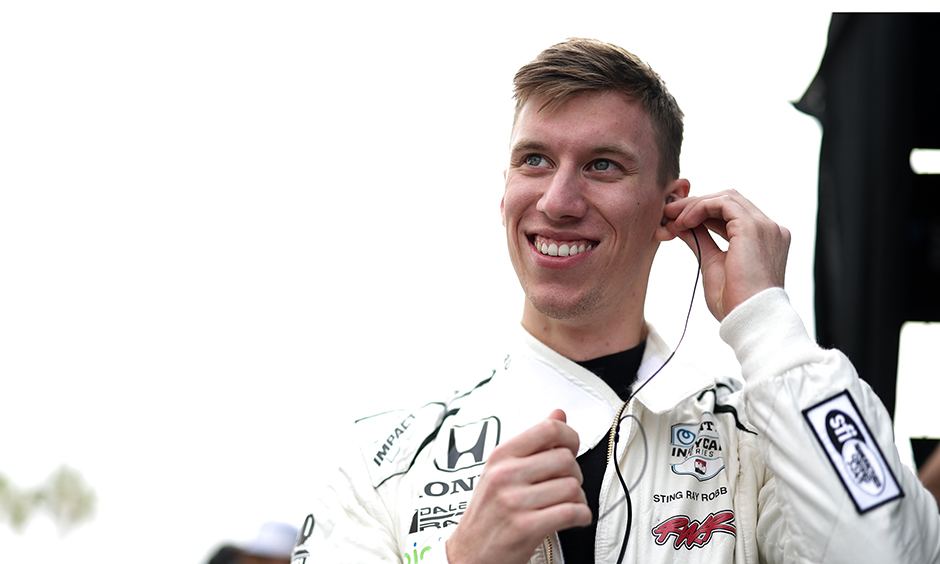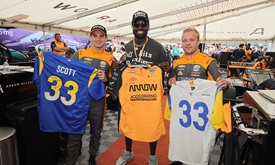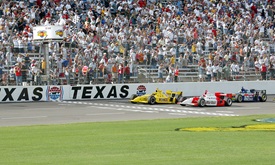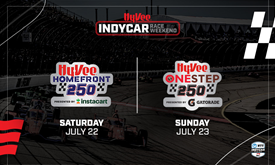Texas 101: Rookie Robb Getting Schooled on Speed Quickly
MAR 24, 2023
Sting Ray Robb is one of three NTT INDYCAR SERIES drivers who will experience racing at Texas Motor Speedway for the first time next weekend. But unlike many series rookies that have come before him, Robb had never seen the high-banked, 1.5-mile track before testing on it last week, and he had never been on a computer that could simulate it.
Robb also had never driven on a superspeedway of any kind, so this experience was certainly eye-opening, especially at speeds approaching 220 mph.
“That was the first time I’ve had my breath taken away by the speed of a car I was driving,” he said.
The driver of the No. 51 biohaven Honda of Dale Coyne Racing with Rick Ware Racing completed nearly 200 laps during the two-day test, joining fellow series rookies Benjamin Pedersen of AJ Foyt Racing and Agustin Canapino of Juncos Hollinger Racing in the session.
The PPG 375 is Sunday, April 2 on NBC, Peacock and the INDYCAR Radio Network.
Robb agreed to give INDYCAR.com an insider’s look at how an INDYCAR SERIES newcomer adapts to the superspeedway in Fort Worth, Texas.
“I think for any driver the extra 40 mph you’re doing at the end of the straightaway (at a superspeedway) doesn’t seem like much more, and that’s not the case,” he said. “Two-hundred twenty (mph) is quick!”
Robb said it took him a half-dozen laps to get the nerve to test the limits of the car.
“Like the fourth or fifth lap I was still in fourth gear and doing around 190 mph,” he said, laughing. “I was like, ‘All right, we’re not messing around anymore, let’s go flat and see what happens, and if I get in trouble then I can lift (off the throttle).’
“It took a couple of laps to wind up (the engine power), and I definitely had to slide my left foot over on top of my right foot to make sure I didn’t lift, but it was fun.”
Robb said the lateral push on his body in the corners, which reached 4 Gs, was more sustained than he expected. Drivers experience similar levels in road racing, but they’re split-second in relative time despite going from side to side depending on the direction of the corner. In part because Robb didn’t have a good place to rest his heel during the Texas test, his left leg glutes were cramping as he worked to keep his right foot on the gas pedal.
Robb said his point of emphasis was hitting the turn-in location in Turn 1.
“Setting your eyesight up the road is a big focus (at Texas) because the (increased) speed is something you have to get used to,” he said. “We calculated that you’re (traveling) at 318 feet per second there, so when you turn in you’re looking as far as the concrete wall (on the left side) allows you to see. If you don’t look that far ahead, your apex is not going to be late enough, and if you have an early apex, you’re just going to wash up to the wall.
“So, the main focus in (Turns) 1 and 2 is getting a good line (out of Turn 2) onto the back straightaway so you can make a good run down to (Turns) 3 and 4. Most passes will happen in some coordination between the run out of 1 and 2 because 3 and 4 are pretty much (full speed) because that corner is easier, as it opens up more on exit, and that allows you to carry the speed because the grip level is there.
“It all goes back to (Turns) 1 and 2. The big focus is getting that late-apex spot correct and (understanding) where the turn-in is. What is the positioning of the hands that’s required to hit that apex at the right point? A superspeedway is not like a road course or street circuit where turning in and hitting the apex is opening your hands and getting off (the corner); it’s a very slow movement. The faster you go (in the car) the slower and smoother you have to be with your hands.”
Robb said a big benefit was having access to watch in-car video of other drivers competing at Texas, particularly that of oval veteran Takuma Sato, who last year drove the same car that Robb is driving this year. Sato, a two-time winner of the Indianapolis 500 presented by Gainbridge, qualified third in last year’s Texas race, so Robb compared his corner lines and hand movements to that of teammate David Malukas and others available on YouTube.
“Just tried to get as much media content in my brain as possible,” he said.
Drivers often say it’s one thing to test at a track, yet another to race there, and that couldn’t be truer of Texas, where next week’s 28-car field will require quick decision-making at every corner.
Robb was asked if he is ready to race there. Again laughing, he wasn’t sure how to answer that.
“I think that’s a trick question because I don’t think any (rookie) is ever ready to race there,” he said. “Texas is such a wild race. The fact we’re doing what we’re doing (in testing), let alone racing on it, is crazy! But I think I will be ready come race day.
“(Success) is a matter of seeing what it’s like there in traffic and what kind of a car do I need? In the test, I got used to the (in-car) tools that we have – the weight jacker, the anti-roll bar, all of those things – so I can get the car good for myself. Especially in race trim, I think that plays even more of a factor because if you’re in the aero wash or out of the aero wash, you’ve got to adjust your tools accordingly otherwise the balance of the car is going to be off.”



















